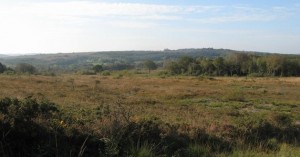Support us from £3/month
We deal with almost 1000 cases a year assisting communities, groups and individuals in protecting their local spaces and paths in all parts of England and Wales. Can you help us by joining as a member?
Article published on Headline Environment website, On the Agenda, 11 September 2012
Commons are unique and precious places to be treasured by all, says Kate Ashbrook, of the Open Spaces Society, as she welcomes the publication of a revised version of A Common Purpose.
Kate Ashbrook writes: Common land has for centuries been a battleground. In 1549 thousands of rebels met on Mousehold Heath near Norwich to demand an end to enclosure. In 1606 a London merchant inclosed part of a common wood near Canterbury, Kent, and built houses around it: angry locals destroyed one of the houses. This century there have been long and contentious public inquiries into fencing of commons to allow grazing, with local people pitched against conservationists.
It should not be so. Commons are unique and precious places to be treasured by all. The revised guidance in A Common Purpose (published on the Foundation for Common Land website) aims to encourage consensus and community involvement in the management of common land.
Unique and precious places

The Pebblebed Heath commons near Budleigh Salterton in East Devon where the owner, the Clinton Devon Estate, working with the RSPB and others has achieved agreed proposals for management of the heathland by following A Common Purpose.
Commons are found throughout England and Wales. There are 1,544 square miles of common land in England, an area about the size of Suffolk. There are 668 square miles in Wales, about one-eighth of the total land area. Commons cover all types of landscape and habitat, from the moors of Dartmoor to the Norfolk coast. They date back to pre-medieval times and there is no other type of land in which so much public interest is concentrated – landscape, wildlife, archaeology and recreation. All commons have an owner. Others, usually from nearby properties, have rights of graze, collect wood and dig peat for example. In the past the exercise of those rights was vital to people’s livelihoods.
Times have changed and in the lowlands people no longer graze stock on commons as their normal farming practice, while speeding traffic makes it risky to graze livestock without fencing. Hence many heathland commons are becoming overgrown with scrub. But the land has immense potential for wildlife, having been undisturbed through history, and managers such as the wildlife trusts, the National Trust and Natural England see commons as a vital opportunity to rescue disappearing habitats and species of flora and fauna. And commons are much loved by the public who has the right to walk on all and ride on many. Communities feel a strong sense of ownership; emotions run high.
Scope for conflict
Thus there is scope for conflict. The Open Spaces Society, which was founded in 1865 to rescue commons from enclosure and destruction, is a keen advocate of agreed solutions for commons management and was an instigator of the first edition of A Common Purpose published in 2005.
A Common Purpose provides guidance to common-land managers on how to engage the community and achieve consensus when works, such as fencing or tree-felling, are contemplated. It encourages land managers to take a step-by-step approach to understanding people’s views and to allow plenty of time for discussion and reflection.
Plans for grazing, scrub-clearance and tree-felling can all meet opposition unless the community is involved in their making. Fencing is often controversial: it may be desirable to enable the common to be grazed, but it’s a physical and psychological barrier and can change the nature of the common.
Involve the local community
The principles advocated in A Common Purpose are relevant both on lowland commons with no active graziers and on upland commons where stakeholders both with and without legal interests have different management objectives.
Any works on common land which prevent or impede access need the consent of the Secretary of State for Environment (or the environment minister in Wales), under section 38 of the Commons Act 2006. The decision is delegated to the Planning Inspectorate, which may hold a public inquiry for complex or contentious cases. The Department for Environment, Food and Rural Affairs (Defra) and the Planning Inspectorate advocate that, before applying for consent for works on a common, the applicant should follow the principles in A Common Purpose. The document has been endorsed by Defra’s National Common Land Stakeholder Group, which consists of all the principal organisations with an interest in commons.
By following the guidance in A Common Purpose land managers will not only secure an agreed future for the common, with community involvement in its future, but they will probably save thousands of pounds by avoiding the need for a public inquiry or litigation. A Common Purpose helps to ensure that common ground is no longer a battleground.
The Open Spaces Society also has a handbook entry on headlineENVIRONMENT
